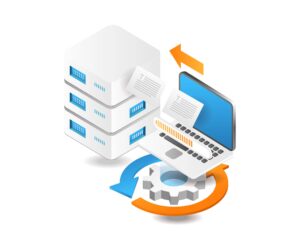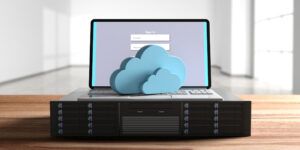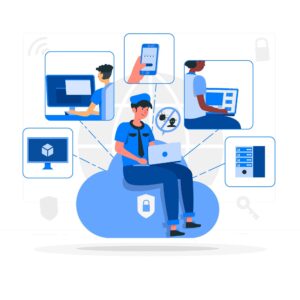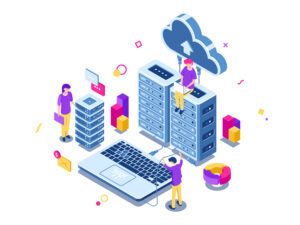
Physical to Physical DR
P2P DR offers a redundant and mirrored environment, ensuring data and system availability in case of disruptions, emphasizing the importance of hardware similarity, continuous replication, thorough testing, and maintenance for a robust disaster recovery strategy.
Replication Strategy: P2P DR involves replicating data and system configurations from one physical location or server to another identical physical setup.
Continuous Replication: Continuous replication ensures that changes made in the primary system are constantly mirrored in the secondary system, minimizing data loss in the event of a disaster.
Hardware and Software Similarity: Both primary and secondary sites require similar hardware configurations and software environments to facilitate seamless failover and recovery.
Backup and Restore Procedures: Establishing robust backup procedures for both data and system configurations is crucial. It involves regular backups and testing of restore procedures to ensure data integrity and recovery readiness.
Network Connectivity and Bandwidth: Strong network connectivity between primary and secondary sites with adequate bandwidth is essential for timely data replication and failover operations.
Failover and Recovery Testing: Regular testing of failover procedures is imperative to validate the effectiveness and reliability of the DR setup, identifying any potential issues or gaps in the recovery process.
Documentation and Maintenance: Detailed documentation of configurations, procedures, and maintenance tasks ensures clarity and facilitates swift recovery during actual disaster scenarios.
Physical to Virtual DR
Physical to Virtual (P2V) Disaster Recovery (DR) includes transitioning from a bodily infrastructure to a virtualized surroundings to enhance resilience and recuperation abilities. Key functions of P2V DR include

Conversion Tools: Utilising tools to convert physical servers or machines into virtualized instances, ensuring compatibility among special hardware and software program environments.
Resource Optimization: Virtual environments offer flexibility, allowing better resource utilisation thru dynamic allocation and scalability of assets primarily based on demand.
Reduced Hardware Dependency: P2V DR reduces dependency on bodily hardware, allowing quicker recuperation and less difficult provisioning of assets, minimising downtime in the course of catastrophe situations.
Backup and Restore Procedures: Establishing robust backup procedures for both data and system configurations is crucial. It involves regular backups and testing of restore procedures to ensure data integrity and recovery readiness.
Centralised Management: Virtual environments permit centralised management, facilitating simpler backup, replication, and tracking of a couple of virtual machines from a single interface.
Snapshot and Recovery Points: Virtualization platforms frequently provide picture abilities, allowing administrators to capture the country of a virtual device at a selected factor, aiding in fast restoration.
Testing and Sandbox Environments: P2V DR allows growing isolated testing environments or sandboxes, permitting testing of catastrophe healing tactics without impacting production structures.
Migration and Recovery Flexibility: Transitioning from bodily to virtual environments offers flexibility in migration strategies and healing alternatives, improving adaptability and agility throughout DR operations.

Physical Cloud DR
Migration Tools and Services: Leveraging gear and services that facilitate the migration of physical servers, records, and packages to the cloud, ensuring compatibility and seamless transition.
Scalability and Elasticity: Cloud environments provide scalability, permitting sources to be scaled up or down primarily based on demand, presenting flexibility and value-efficiency at some point of regular operations and catastrophe situations.
Reduced Infrastructure Dependency: P2C DR reduces reliance on bodily hardware, casting off the want for keeping on-premises infrastructure, thereby reducing operational expenses and complexities.
High Availability and Redundancy: Cloud vendors provide redundancy across multiple facts facilities and areas, making sure excessive availability of offerings and data, minimising downtime throughout screw ups.
Automated Backups and Recovery: Cloud-based totally DR answers frequently encompass automatic backup mechanisms and simplified recovery procedures, permitting speedy restoration of data and packages
Pay-as-You-Go Model: Cloud-primarily based DR solutions observe a pay-as-you-cross version, allowing companies to pay only for the resources used in the course of the recuperation process, optimising price-effectiveness.
Testing and Validation: Cloud environments permit clean setup of check environments, permitting corporations to perform ordinary DR drills and validate recovery strategies without impacting manufacturing systems
P2C DR techniques : Offer more advantageous flexibility, scalability, price-efficiency, and resilience, empowering companies to leverage cloud generation for sturdy catastrophe recuperation competencies at the same time as reducing dependency on bodily infrastructure
Virtual to Virtual DR
Virtual to Virtual Disaster Recovery (V2V DR) is a crucial component of modern business resilience, ensuring the seamless recovery of virtualized environments in the face of disruptions. Key features include:

Efficient Replication: V2V DR enables efficient replication of virtual machines, ensuring data consistency and integrity during the recovery process.
Reduced Downtime: Swift recovery times minimize downtime, allowing organizations to quickly resume operations and mitigate the impact on productivity.
Cost-Effective: Virtualized environments contribute to cost savings by eliminating the need for extensive physical infrastructure and providing a scalable recovery solution.
Testing Capabilities: V2V DR allows for regular testing of disaster recovery procedures, ensuring the effectiveness of the recovery plan without impacting the production environment.
Automation: Automated processes streamline the replication and recovery, reducing the manual intervention required during disaster scenarios.
Virtual to Virtual Disaster Recovery is a resilient solution that optimizes recovery times and enhances the overall reliability of virtualized environments in the event of unexpected disruptions.

Virtual to Cloud DR
Virtual to Cloud Disaster Recovery (V2C DR) is a strategic solution ensuring the seamless recovery of virtualized environments in cloud-based infrastructures. Key features include:
Efficient Replication to the Cloud: V2C DR enables streamlined replication of virtual machines to cloud environments, ensuring data consistency and availability.
Scalability: Cloud-based recovery solutions offer scalability, accommodating the dynamic needs of evolving business environments.
Reduced Capital Expenditure: By leveraging cloud resources, organizations can reduce the capital expenditure associated with maintaining extensive physical infrastructure for disaster recovery.
Automated Recovery Processes: V2C DR automates replication and recovery procedures, minimizing manual intervention and expediting the restoration of services.
Testing Capabilities: Allows for regular testing of disaster recovery plans in the cloud, ensuring the readiness of the recovery processes.
Virtual to Cloud Disaster Recovery optimizes data resilience, offering a flexible and scalable solution for organizations looking to enhance their disaster recovery capabilities in virtualized environments.
Cloud to Cloud DR
Cloud to Cloud Disaster Recovery (C2C DR) is a vital strategy ensuring the resilience of cloud-based environments in the face of disruptions. Key features include:

Inter-Cloud Replication: C2C DR facilitates efficient replication of data and applications from one cloud to another, ensuring redundancy and availability.
Geographic Diversity: By leveraging multiple cloud providers, organizations enhance geographic diversity, minimizing the impact of regional outages.
Scalability: Cloud to Cloud DR provides scalable solutions, allowing businesses to adapt to changing data and application needs.
Automated Failover: Automated processes streamline failover procedures, enabling quick and seamless transitions to the backup cloud environment.
Continuous Monitoring: Real-time monitoring ensures the availability of cloud-based resources, providing proactive alerts and mitigating potential issues.
Cloud to Cloud Disaster Recovery is a robust solution, offering organizations the flexibility and redundancy needed to safeguard their data and applications in cloud environments, ensuring uninterrupted business operations.

Cloud to Virtual DR
Cloud to Virtual Disaster Recovery (C2V DR) is a strategic solution ensuring the resilience of virtualized environments by leveraging cloud resources. Key features include:
Efficient Replication: Streamlines replication of data and applications from the cloud to virtualized environments, ensuring data consistency and availability.
Cost-Effective Recovery: By utilizing virtualized infrastructure, organizations reduce the costs associated with maintaining extensive physical infrastructure for disaster recovery.
Scalability: Cloud to Virtual DR offers scalability, accommodating evolving business needs and variations in data and application requirements.
Automated Recovery Processes: Automates replication and recovery procedures, reducing manual intervention and expediting the restoration of services.
Testing Capabilities: Enables organizations to conduct regular testing of disaster recovery plans in virtual environments, ensuring the readiness of recovery processes.
Cloud to Virtual Disaster Recovery optimizes data resilience, providing a flexible and cost-effective solution for organizations seeking to enhance their disaster recovery capabilities in the dynamic digital landscape.
Database Replication
Database Replication is a pivotal strategy for ensuring data availability, consistency, and disaster recovery. Key features include:

Real-Time Replication: Ensures up-to-date copies of data across multiple database instances, minimizing the risk of data inconsistencies.
High Availability: Enhances system reliability by creating redundant copies of the database, reducing the impact of potential hardware failures.
Load Balancing: Distributes read and write operations among replicated databases, optimizing resource utilization and improving overall performance.
Disaster Recovery: Serves as a crucial component of disaster recovery plans, allowing organizations to quickly restore operations with minimal data loss.
Geographic Diversity: Supports replication across geographically dispersed locations, providing resilience against regional outages or disasters.
Consolidated Reporting: Facilitates consolidated reporting and analytics by centralizing data from multiple database replicas.
Database Replication ensures data integrity, availability, and resilience, playing a pivotal role in maintaining business continuity and optimizing performance across diverse scenarios.

Physical Server Backup
Physical server backup answers are crucial for retaining and restoring data from on-premises servers. These solutions provide numerous key functions:
Full System Backup: They create comprehensive backups of whole physical servers, such as running systems, programs, configurations, and records, ensuring entire recovery competencies
Incremental and Differential Backups: Physical server backup answers frequently provide options for incremental or differential backups, allowing customers to backup only the adjustments made because the final backup, decreasing backup time and storage necessities.
Scheduled and Automated Backups: Users can schedule normal backups, automating the manner to ensure steady statistics protection without guide intervention.
Flexible Recovery Options: These solutions provide numerous recuperation options, allowing users to restore whole systems or choose precise documents, folders, or programs based totally on their recuperation needs.
Encryption and Security Measures: To shield sensitive records, physical server backup solutions frequently provide encryption options, making sure that backed-up records remain steady at some point of transmission and storage.
Offline and Cloud Storage Support: They aid storing backups on outside gadgets, tapes, or cloud storage, providing flexibility in storage options to match special restoration scenarios and compliance needs.
Verification and Integrity Checks: Backup answers encompass capabilities to verify the integrity of backups, making sure that facts are recoverable and unfastened from corruption while wanted.
Reporting and Monitoring: Some solutions offer tracking capabilities and precise reporting on backup reputation, mistakes, or of completion, allowing administrators to music backup overall performance and take important moves.
Virtual Server Backup
Virtual Server Backup is a crucial component of modern data management, ensuring the protection and recovery of virtualized environments. Key features include:

Incremental Backups: Efficiently captures changes to data since the last backup, optimizing storage and backup speed.
Snapshot Technology: Utilizes snapshot technology to create point-in-time copies for quick recovery and minimal data loss.
Application Consistency: Ensures consistency across applications during backup, preserving data integrity.
Flexible Recovery Options: Allows for granular recovery of files, folders, or entire virtual machines, providing flexibility in data restoration.
Automated Scheduling: Facilitates regular and automated backup schedules, reducing the need for manual intervention.
Integration with Hypervisors: Seamlessly integrates with virtualization platforms, supporting major hypervisors for comprehensive compatibility.
Compression and Deduplication: Optimizes storage space by compressing and deduplicating backup data, enhancing efficiency.
Virtual Server Backup guarantees the resilience of virtualized environments, offering a comprehensive solution that combines efficiency, flexibility, and reliable data recovery.

Azure DR Services
Azure gives numerous Disaster Recovery (DR) services designed to ensure commercial enterprise continuity and data protection in case of unforeseen outages or screw ups. Some key Azure DR services consist of:
Azure Site Recovery (ASR): ASR allows replication, failover, and failback of virtual machines and physical servers to Azure, supplying automated catastrophe recovery capabilities. It supports various replication scenarios, inclusive of Azure-to-Azure, Hyper-V, VMware, and physical servers to Azure.
Azure Backup: Azure Backup is a scalable and secure cloud-based totally backup carrier that allows businesses to defend crucial facts with the aid of backing up documents, folders, programs, and machine states to Azure. It offers features along with backup retention rules, encryption, and long-term information retention
Azure Traffic Manager: While now not completely a DR provider, Traffic Manager plays a position in DR by enabling the distribution of incoming azure visitors across multiple Azure areas, supporting application availability in case of nearby screw ups
Azure Storage Redundancy: Azure Storage offers redundancy options like Locally Redundant Storage (LRS), Zone-Redundant Storage (ZRS), Geo-Redundant Storage (GRS), and Read-Access Geo-Redundant Storage (RA-GRS) to make certain facts resilience throughout multiple facts facilities and areas.
Azure Virtual Machine Scale Sets: These enable automatic scaling of applications primarily based on demand, ensuring high availability and overall performance for the duration of unexpected visitors surges or screw ups.
AWS DR Services
Amazon Web Services (AWS) provides a suite of Disaster Recovery (DR) services to assist companies establish resilient and efficient recuperation solutions. Key AWS DR offerings consist of:

AWS Backup: A centralised backup carrier allowing automatic and scheduled backups across diverse AWS offerings like Amazon EBS, RDS, DynamoDB, and more, simplifying backup management and retention.
AWS Disaster Recovery Solution: Utilising more than one AWS area, organisations can reflect applications and facts across regions to establish failover and redundancy, making sure high availability and quick recuperation in case of disruptions.
AWS CloudEndure Disaster Recovery: Acquired through AWS, CloudEndure offers non-stop replication and automated recovery, permitting speedy failover with minimum information loss, ideal for on-premises and cloud-primarily based packages.
Amazon S3 Replication: Amazon S3 presents move-area replication, permitting businesses to duplicate facts throughout more than one area, improving facts sturdiness and making sure availability for disaster restoration situations.
AWS Direct Connect: Offering a committed community connection between on-premises environments and AWS, Direct Connect guarantees a secure and excessive-bandwidth link for faster records switch at some stage in DR operations.
These AWS DR services empower groups to build comprehensive and scalable disaster restoration solutions, leveraging AWS’s global infrastructure to protect facts, preserve software availability, and decrease downtime for the duration of unexpected incidents or screw ups.